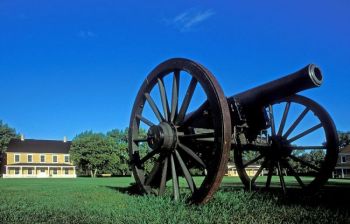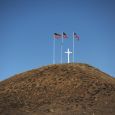The Gift of South Dakota
Subscriptions to South Dakota Magazine make great gifts!
Subscribe today — 1 year (6 issues) is just $29!
What Does the Civil War Have to do With Dakota Territory?
Aug 23, 2012
Think of the Civil War and what comes to mind? We all learned about Bull Run, Vicksburg, Gettysburg, Antietam, Shiloh and Robert E. Lee’s final surrender at Appomattox Courthouse. But are you familiar with the Battle of Whitestone Hill? The Battle of Killdeer Mountain? The Battle of the Badlands?
They aren’t as prominent in Civil War history because they didn’t directly affect the outcome of the conflict. But they are important here because all three battles took place in Dakota Territory and greatly affected how this region was settled.
We’re in the midst of commemorating the 150th anniversary of the Civil War as well as the 150th anniversary of the Dakota Uprising in Minnesota (another important regional clash during the Civil War period). To discuss Dakota Territory’s role in the war that divided our nation for four years, a series of programs is planned around the state beginning this weekend and continuing through the fall.
“Back East it was the Civil War. Out here on the Northern Plains it was a whole different situation,” says Brad Tennant, an associate professor of history at Presentation College in Aberdeen and discussion leader for a portion of the series. “I think it’s often overlooked.”
The first tragic event was the Dakota War of 1862, which ended with the executions of 38 Dakota warriors, the largest mass execution in U.S. history. Following the uprising in September 1863, the military dispatched Gen. Alfred Sully up the Missouri River through Dakota Territory in pursuit of hostiles who had fled Minnesota. He found an encampment at Whitestone Hill, about 80 miles northwest of Aberdeen. Sully’s troops murdered nearly 300 Yanktonais, Dakota, Hunkpapa Lakota and Blackfeet. As it happened, none had been involved in the Minnesota conflict. “It’s North Dakota’s counterpart to Wounded Knee,” Tennant explains.
The next clash between Sully and the Indians came at Killdeer Mountain in June 1864. More than 1,600 warriors fought Sully’s force of 2,200 men. Estimates range from 31 to 150 Sioux warriors killed, compared to five U.S. Army soldiers. The Battle of the Badlands followed in August 1864 near Medora, with another 100 to 300 Indians killed.
Not surprisingly Dakota Territory promoters had a difficult time convincing Easterners to settle on the Plains. Tennant cited a study by former University of South Dakota professor Thomas Gasque that found only three South Dakota cities with a population greater than 1,000 possessing a name of Indian origin: Sisseton, Yankton and Sioux Falls. “That’s not just a coincidence,” Tennant notes. “Most of our places were named after people or geographic features, simply to make it sound less Indian, and to convince Easterners that the territory was not as hostile as they may have been led to believe.”
There’s much more to learn about the Civil War period in Dakota Territory at these upcoming discussion sessions.
Aug. 26, Sept. 16 and Oct. 7: Klein Museum, Mobridge
Sept. 6, Oct. 18 and Nov. 8: Public Library, Sturgis
Oct. 4, Nov. 1 and Dec. 6: Siouxland Library Main Branch, Sioux Falls
Oct. 11, Oct. 20 and Nov. 4: South Dakota Cultural Heritage Center, Pierre











Comments